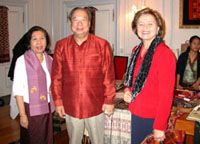French designer weaves past and present in Laos textile workshop
French textile designer Anou Thammavong left his birthplace of Laos when he was only a child. When he returned there six years ago, he was hoping to find his roots.

To his surprise, he discovered his calling: to revive his grandmother's weaving business, abandoned when his family fled the Communist takeover of the Southeast Asian country in 1975.
"When I turned 30, I immediately felt this urge to go back to my roots, to return to Laos I wanted to find myself," said Thammavong, 35, sitting in his Paris apartment surrounded by piles of intricately woven silk stoles. "I fell in love with Laos."
Growing up in France, he had listened with fascination to his grandmother's tales of a glamorous former life in the Lao royal court, where her husband was foreign minister and her brother-in-law the ambassador to France.
During a state visit to France in the mid-1950s, she had visited a textile mill in Lyon and become smitten with its fine silks. Upon her return to Laos, she set about modernizing traditional Lao weaving by setting up her own workshop, using new colors and patterns.
After her departure, it seemed that those creations would be lost forever, as most weavers abandoned the labor-intensive fabrics that few people could afford under the Communist regime.
One man continued her work on his rickety loom. A chance encounter with this former employee persuaded Thammavong to quit his job in Paris and bring the old traditional techniques back to life.
"I have no training in fashion, none at all. Everything I learned, everything I am doing now, I learned it with this weaver. I think it was instinctive too," he recalled.
Thammavong set about learning the complex techniques required to produce rich geometrical patterns inspired by everything from monsoon rains to elephants or the religious symbols of Buddhism.
To make a single stole, the weaver has to stand up and adjust his loom up to 240 times, a challenge both physical and intellectual, as mapping out the pattern requires a mathematical mind-set.
The very fine silk Thammavong uses makes the process even more painstaking a weaver will typically produce just 15-25 centimeters (6-10 inches) per day.
Thammavong now lives in Laos seven months in the year and employs five female weavers who produce stoles for his Soie de Lune collection in addition to textiles for the home.
His creations have caught the eye of U.S. designer Ralph Rucci, who has featured the stoles in his catwalk shows in New York for the last two seasons and is distributing them with his ready-to-wear.
Thammavong uses only biodegradable soaps and natural dyes, such as madder root or cochineal bug for the reds, Campeche logwood for black and trumpet-wood for light greens and yellows, reports AP.
Because the designer produces only limited amounts of each dye and some natural ingredients are subject to seasonal variations, no two stoles are exactly alike.
Subscribe to Pravda.Ru Telegram channel, Facebook, RSS!

